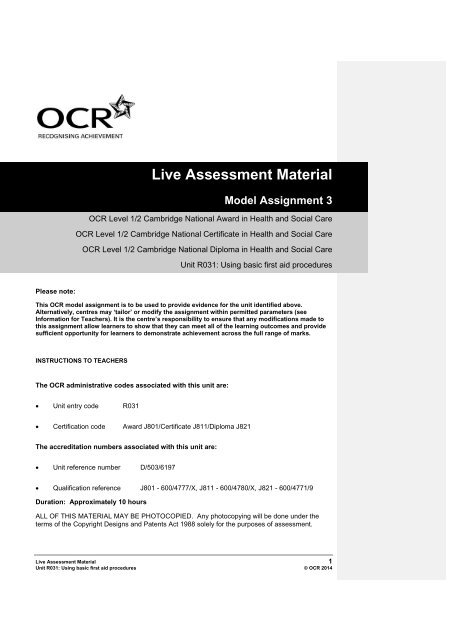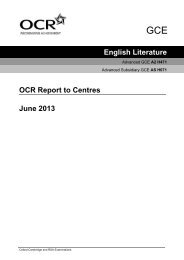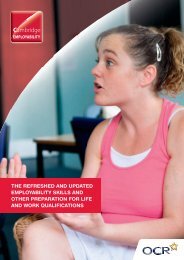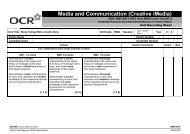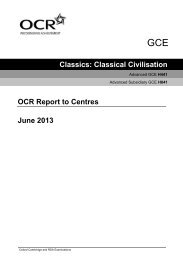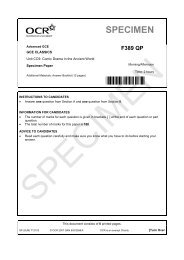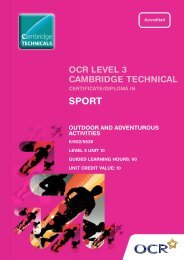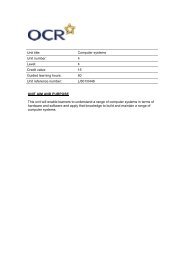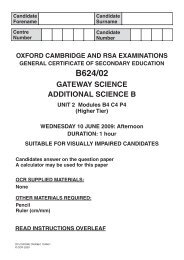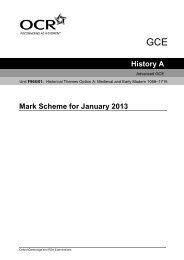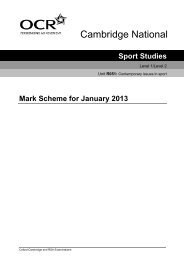Unit R031 - Using basic first aid procedures - Model ... - OCR
Unit R031 - Using basic first aid procedures - Model ... - OCR
Unit R031 - Using basic first aid procedures - Model ... - OCR
You also want an ePaper? Increase the reach of your titles
YUMPU automatically turns print PDFs into web optimized ePapers that Google loves.
Live Assessment Material<br />
<strong>Model</strong> Assignment 3<br />
<strong>OCR</strong> Level 1/2 Cambridge National Award in Health and Social Care<br />
<strong>OCR</strong> Level 1/2 Cambridge National Certificate in Health and Social Care<br />
<strong>OCR</strong> Level 1/2 Cambridge National Diploma in Health and Social Care<br />
<strong>Unit</strong> <strong>R031</strong>: <strong>Using</strong> <strong>basic</strong> <strong>first</strong> <strong>aid</strong> <strong>procedures</strong><br />
Please note:<br />
This <strong>OCR</strong> model assignment is to be used to provide evidence for the unit identified above.<br />
Alternatively, centres may ‘tailor’ or modify the assignment within permitted parameters (see<br />
Information for Teachers). It is the centre’s responsibility to ensure that any modifications made to<br />
this assignment allow learners to show that they can meet all of the learning outcomes and provide<br />
sufficient opportunity for learners to demonstrate achievement across the full range of marks.<br />
INSTRUCTIONS TO TEACHERS<br />
The <strong>OCR</strong> administrative codes associated with this unit are:<br />
<strong>Unit</strong> entry code <strong>R031</strong><br />
Certification code Award J801/Certificate J811/Diploma J821<br />
The accreditation numbers associated with this unit are:<br />
<strong>Unit</strong> reference number D/503/6197<br />
Qualification reference J801 - 600/4777/X, J811 - 600/4780/X, J821 - 600/4771/9<br />
Duration: Approximately 10 hours<br />
ALL OF THIS MATERIAL MAY BE PHOTOCOPIED. Any photocopying will be done under the<br />
terms of the Copyright Designs and Patents Act 1988 solely for the purposes of assessment.<br />
Live Assessment Material 1<br />
<strong>Unit</strong> <strong>R031</strong>: <strong>Using</strong> <strong>basic</strong> <strong>first</strong> <strong>aid</strong> <strong>procedures</strong> © <strong>OCR</strong> 2014
<strong>OCR</strong> Level 1/Level 2 Cambridge Nationals in Health and Social Care<br />
Contents<br />
INFORMATION FOR LEARNERS<br />
Scenario for the assignment (setting the scene)<br />
This section contains the assignment background which learners will need<br />
to be familiar with in order to complete the tasks.<br />
Page Number(s)<br />
3<br />
4<br />
Your tasks<br />
This section contains all the tasks learners must complete before work can<br />
be submitted for assessment.<br />
5–6<br />
INFORMATION FOR TEACHERS<br />
General guidance on using this assignment<br />
This section provides general guidance to centre staff on the preparation<br />
and completion of the assignment.<br />
7–19<br />
Specific guidance on the tasks<br />
This section provides guidance on managing the assessment and includes a<br />
number of scenarios.<br />
14<br />
Evidence summary<br />
This section provides a summary of the evidence it is expected the learner<br />
will produce for this assignment.<br />
15–20<br />
Witness statement<br />
2 Live Assessment Material<br />
© <strong>OCR</strong> 2014 <strong>Unit</strong> <strong>R031</strong>: <strong>Using</strong> <strong>basic</strong> <strong>first</strong> <strong>aid</strong> <strong>procedures</strong>
<strong>OCR</strong> Level 1/Level 2 Cambridge Nationals in Health and Social Care<br />
<strong>Model</strong> Assignment: Information for Learners<br />
<strong>OCR</strong> Level 1/2 Cambridge National Award in Health and Social Care<br />
<strong>OCR</strong> Level 1/2 Cambridge National Certificate in Health and Social Care<br />
<strong>OCR</strong> Level 1/2 Cambridge National Diploma in Health and Social Care<br />
Live Assessment Material 3<br />
<strong>Unit</strong> <strong>R031</strong>: <strong>Using</strong> <strong>basic</strong> <strong>first</strong> <strong>aid</strong> <strong>procedures</strong> © <strong>OCR</strong> 2014
Scenario for the assignment<br />
<strong>OCR</strong> Level 1/Level 2 Cambridge Nationals in Health and Social Care<br />
Setting the scene – using <strong>basic</strong> <strong>first</strong> <strong>aid</strong> <strong>procedures</strong><br />
Your local council is promoting a <strong>first</strong> <strong>aid</strong> course. As you are involved in local community work you<br />
have signed up for the course. You will need to show that you can assess the scene of an accident<br />
and know how to demonstrate suitable practical <strong>first</strong> <strong>aid</strong> skills.<br />
You have been asked to produce evidence that you know:<br />
<br />
<br />
<br />
how to seek additional support<br />
the information needed for emergency services<br />
<strong>first</strong> <strong>aid</strong> <strong>procedures</strong>.<br />
You will give a practical demonstration to show how to:<br />
<br />
<br />
assess the scene of an accident<br />
apply <strong>basic</strong> <strong>first</strong> <strong>aid</strong> <strong>procedures</strong>.<br />
Comment [E1]: Full stop<br />
Finally you will review your practical demonstration.<br />
Read through all of the tasks carefully, so that you know what you will<br />
need to do to complete this assignment.<br />
4 Live Assessment Material<br />
© <strong>OCR</strong> 2014 <strong>Unit</strong> <strong>R031</strong>: <strong>Using</strong> <strong>basic</strong> <strong>first</strong> <strong>aid</strong> <strong>procedures</strong>
<strong>OCR</strong> Level 1/Level 2 Cambridge Nationals in Health and Social Care<br />
Your tasks<br />
Task 1: Assessing the scene<br />
This task covers part of Learning Outcome 1: Be able to assess scenes of accidents<br />
to identify risks and continuing dangers<br />
The <strong>first</strong> action you need to take when there is an accident is to assess the scene.<br />
You need to:<br />
<br />
<br />
<br />
<br />
assess the dangers to the casualty, the <strong>first</strong> <strong>aid</strong>er and others<br />
consider how the area can be made safe<br />
obtain informed consent<br />
demonstrate clear communication.<br />
Comment [E2]: Full stop<br />
You will need to take part in a role play to demonstrate these skills. A witness statement is required<br />
and will comment on your assessment of the scene.<br />
Comment [E3]: “on”<br />
Task 2: Additional support<br />
This task covers part of Learning Outcome 1: Be able to assess scenes of accidents<br />
to identify risks and continuing dangers<br />
When dealing with accidents you may need to seek additional support.<br />
You should describe:<br />
<br />
<br />
<br />
when and how to seek additional support<br />
why the people reported to are appropriate<br />
the information you should supply to the emergency services.<br />
Comment [E4]: Full stop<br />
Live Assessment Material 5<br />
<strong>Unit</strong> <strong>R031</strong>: <strong>Using</strong> <strong>basic</strong> <strong>first</strong> <strong>aid</strong> <strong>procedures</strong> © <strong>OCR</strong> 2014
<strong>OCR</strong> Level 1/Level 2 Cambridge Nationals in Health and Social Care<br />
Task 3: Understanding <strong>first</strong> <strong>aid</strong> <strong>procedures</strong><br />
This task covers Learning Outcome 2: Understand the <strong>first</strong> <strong>aid</strong> <strong>procedures</strong> for a<br />
range of injuries<br />
You must provide information about how to identify the nature and severity of the injuries listed<br />
below, the current <strong>first</strong> <strong>aid</strong> <strong>procedures</strong> for these injuries and the rationale (reasons) for the<br />
<strong>procedures</strong>.<br />
Range of injuries:<br />
<br />
<br />
<br />
<br />
<br />
<br />
conscious/unconscious and breathing/not breathing<br />
choking<br />
an asthma attack<br />
burns or scalds<br />
bleeding<br />
shock.<br />
Comment [E5]: Full stop<br />
For each of the injuries provide information about:<br />
<br />
<br />
<br />
<br />
<br />
possible causes<br />
severity<br />
symptoms<br />
the correct sequence of steps in the current <strong>first</strong> <strong>aid</strong> <strong>procedures</strong><br />
rationale.<br />
Comment [E6]: Full stop?<br />
Task 4: Demonstrate <strong>first</strong> <strong>aid</strong> <strong>procedures</strong><br />
This task covers part of Learning Outcome 3: Be able to apply <strong>basic</strong> <strong>first</strong> <strong>aid</strong><br />
<strong>procedures</strong><br />
You need to demonstrate the current <strong>first</strong> <strong>aid</strong> procedure, in the correct sequence of steps, for each<br />
of the following:<br />
<br />
<br />
<br />
<br />
<br />
<br />
conscious/unconscious and breathing/not breathing<br />
choking<br />
an asthma attack<br />
burns or scald<br />
bleeding<br />
shock.<br />
Comment [E7]: Full stop<br />
A witness statement will need to be provided commenting on how you completed your <strong>first</strong> <strong>aid</strong><br />
<strong>procedures</strong>.<br />
6 Live Assessment Material<br />
© <strong>OCR</strong> 2014 <strong>Unit</strong> <strong>R031</strong>: <strong>Using</strong> <strong>basic</strong> <strong>first</strong> <strong>aid</strong> <strong>procedures</strong>
<strong>OCR</strong> Level 1/Level 2 Cambridge Nationals in Health and Social Care<br />
Task 5: Review<br />
This task covers part of Learning Outcome 3: Be able to apply <strong>basic</strong> <strong>first</strong> <strong>aid</strong><br />
<strong>procedures</strong><br />
You now need to produce a review of your practical <strong>first</strong> <strong>aid</strong> skills.<br />
Your review must cover:<br />
your competency<br />
your strengths and weaknesses<br />
suggested improvements to your performance. Comment [E8]: Full stop<br />
Live Assessment Material 7<br />
<strong>Unit</strong> <strong>R031</strong>: <strong>Using</strong> <strong>basic</strong> <strong>first</strong> <strong>aid</strong> <strong>procedures</strong> © <strong>OCR</strong> 2014
<strong>OCR</strong> Level 1/Level 2 Cambridge Nationals in Health and Social Care<br />
Information for Teachers<br />
<strong>OCR</strong> Level 1/2 Cambridge National Award in Health and Social Care<br />
<strong>OCR</strong> Level 1/2 Cambridge National Certificate in Health and Social Care<br />
<strong>OCR</strong> Level 1/2 Cambridge National Diploma in Health and Social Care<br />
<strong>Unit</strong> <strong>R031</strong>: <strong>Using</strong> <strong>basic</strong> <strong>first</strong> <strong>aid</strong> <strong>procedures</strong><br />
8 Live Assessment Material<br />
© <strong>OCR</strong> 2014 <strong>Unit</strong> <strong>R031</strong>: <strong>Using</strong> <strong>basic</strong> <strong>first</strong> <strong>aid</strong> <strong>procedures</strong>
<strong>OCR</strong> Level 1/Level 2 Cambridge Nationals in Health and Social Care<br />
General guidance on using this assignment<br />
1 General guidance<br />
1.1 <strong>OCR</strong> assignments are available to download free of charge from our website:<br />
www.ocr.org.uk<br />
1.2 <strong>OCR</strong> assignments are intended to be used for summative assessment of learners. The<br />
<strong>OCR</strong> specification for this qualification gives more information on the arrangements for<br />
assessing internally assessed units.<br />
1.3 This assignment has been designed to meet the full assessment requirements of the<br />
unit. Learners will need to take part in a planned learning programme that covers the<br />
underpinning knowledge, understanding and skills of the unit.<br />
2 Before carrying out this assignment<br />
2.1 Learners should be provided with a copy of the Information for Learners section of this<br />
assignment.<br />
2.2 Learners will not need to carry out any preparations prior to undertaking the<br />
assessment tasks, such as collating resources to use in the assessment.<br />
2.3 We have estimated that it will take approximately ten hours to complete all tasks.<br />
Learners would need approximately 30 minutes to complete task 1, 1 hour to complete<br />
task 2, 6 - 7 hours to complete task 3, 1 hour to complete task 4, and 1 hour to<br />
complete task 5. These timings are for guidance only but should be used by the<br />
teacher to give learners an indication of how long to spend on each task. Centres can<br />
decide how the time can be allocated between each part or individual task. Centres are<br />
also permitted to spread the tasks across several sessions and therefore it is<br />
permissible for evidence to be produced over several sessions.<br />
3 When completing the assignment and producing evidence<br />
3.1 Each learner must produce individual and authentic evidence for each task within the<br />
assignment.<br />
3.2 Centre staff may give support and guidance to learners. This support and guidance<br />
should focus on checking that learners understand what is expected of them and giving<br />
general feedback that enables the learner to take the initiative in making<br />
improvements, rather than detailing the amendments. It is not acceptable for<br />
teachers/deliverers to provide answers or to work through answers in detail.<br />
3.3 Learners may use information from any relevant source to help them with producing<br />
evidence for the tasks.<br />
Live Assessment Material 9<br />
<strong>Unit</strong> <strong>R031</strong>: <strong>Using</strong> <strong>basic</strong> <strong>first</strong> <strong>aid</strong> <strong>procedures</strong> © <strong>OCR</strong> 2014
<strong>OCR</strong> Level 1/Level 2 Cambridge Nationals in Health and Social Care<br />
3.4 Learners must be guided on the use of information from other sources to ensure that<br />
confidentiality is maintained at all times. It is acknowledged that learners in their<br />
responses may refer to situations in the scenario we have provided but as the scenario<br />
is fictitious this does not break any rules of confidentiality.<br />
3.5 We have specified what evidence the learner is expected to produce. Usually, the type<br />
of evidence provided may be modified, with the exception of certain types of evidence<br />
listed below under ‘Permitted changes’. Format must not be confused with the content<br />
or the type of evidence to be produced and it is important to note that it is possible to<br />
generate the evidence in a variety of formats. Centres must advise learners as to the<br />
most appropriate format of evidence. The assessment is structured so that learners<br />
are required to provide evidence of using appropriate Health and Social Care<br />
techniques to meet specified purposes. It is unlikely that evidence of the techniques<br />
used, will on their own, provide sufficient evidence to judge the extent to which they<br />
have been used appropriately. Annotations may help to provide this additional context.<br />
The section Evidence Summary at the back of this document will guide you on the type<br />
of evidence and formats for evidence.<br />
4 Presentation of work for marking and moderation<br />
4.1 Centres wishing to produce digital evidence in the form of an e-portfolio should refer to<br />
the appendix in the specification on guidance for the production of electronic<br />
assessment.<br />
4.2 Centres may wish to discourage learners from excessive use of plastic wallets for<br />
presentation of their evidence as this may hinder the assessment process. Instead<br />
centres may wish to encourage learners to present their work so that it is easily<br />
accessible, e.g. spiral bound, stapled booklet, treasury tag.<br />
5 Scope of permitted model assignment modification<br />
The model assignment is very self-contained in its present form. The set of tasks form a coherent<br />
whole, addressing all the learning outcomes and allowing access to the full range of marks.<br />
You must not change the following:<br />
<br />
<br />
<br />
<br />
the learning outcomes<br />
the marking criteria<br />
the requirements for supervision and authentication as described in the specification<br />
(section The internally assessed units)<br />
the requirement to carry out a demonstration of:<br />
assessment of the scene<br />
<strong>basic</strong> <strong>first</strong> <strong>aid</strong> <strong>procedures</strong>.<br />
10 Live Assessment Material<br />
© <strong>OCR</strong> 2014 <strong>Unit</strong> <strong>R031</strong>: <strong>Using</strong> <strong>basic</strong> <strong>first</strong> <strong>aid</strong> <strong>procedures</strong>
<strong>OCR</strong> Level 1/Level 2 Cambridge Nationals in Health and Social Care<br />
Permitted changes:<br />
The model assignment can be modified in terms of the areas described below at the permission of<br />
<strong>OCR</strong> but centres must be sure that learners still have the opportunity to cover all of the learning<br />
outcomes and to access the full range of marks:<br />
<br />
<br />
<br />
<br />
The learner’s assignment may be contextualised or amended to suit local needs. Any local<br />
health or social care setting could be used as a focus.<br />
Who the individual is and their learning needs.<br />
Each specific task may be appropriately contextualised to match with any permitted changes<br />
you have made to the scenario.<br />
The type of evidence required and its format.<br />
<strong>OCR</strong> has ensured that in the language used and the tasks and scenario provided we have avoided<br />
discrimination, bias and stereotyping and support equality and diversity. In the development of<br />
qualifications and assessments we use the guidance given in the Ofqual publication Fair access by<br />
design, notably this includes:<br />
<br />
<br />
using language and layout in assessment materials that does not present barriers to<br />
learners<br />
using stimulus and source materials in assessment materials (where appropriate) that do<br />
not present barriers to learners.<br />
If centres wish to adapt the model assignment we strongly advise that staff responsible for<br />
modifying the model assignment and quality assuring it refer to the publication Fair access by<br />
design.<br />
If modifications are made to the model assignment, whether to just the scenario or to both<br />
the scenario and individual tasks, it is up to the centre to ensure that all learning outcomes<br />
can be met and that learners can access the full range of marks.<br />
Live Assessment Material 11<br />
<strong>Unit</strong> <strong>R031</strong>: <strong>Using</strong> <strong>basic</strong> <strong>first</strong> <strong>aid</strong> <strong>procedures</strong> © <strong>OCR</strong> 2014
<strong>OCR</strong> Level 1/Level 2 Cambridge Nationals in Health and Social Care<br />
Specific guidance on the tasks<br />
Introduction to the tasks<br />
These guidance notes should be used in conjunction with the specification.<br />
The tasks have been designed to enable learners to demonstrate their knowledge and<br />
understanding of how to assess the scene of an accident in health and social care settings for risks<br />
and continuing dangers. Learners will need to understand and be able to carry out a variety of<br />
<strong>basic</strong> <strong>first</strong> <strong>aid</strong> <strong>procedures</strong> for a range of injuries.<br />
This unit must be delivered by a suitably qualified person, eg. the holder of a current <strong>first</strong> <strong>aid</strong><br />
training qualification.<br />
In this section is a table of suggested scenarios with illustrations of the set up which may be used<br />
for Tasks 1 and 4.<br />
This unit can only be evidenced in the context of adult individuals.<br />
Specific guidance on Task 1: Assessing the scene and demonstrating <strong>first</strong> <strong>aid</strong><br />
<strong>procedures</strong>.<br />
Learners need to assess the scene of an accident. Suggested scenarios are provided in this<br />
section, the tutor should choose a scenario which is most appropriate to the learner and set up a<br />
role play.<br />
Learners must adopt the role of the person who is dealing with the accident situation. The accident<br />
victim must be role played by someone who will allow learners to access the full mark range.<br />
The assessor/tutor should sit in an unobtrusive position but should be able to fully observe and<br />
hear the role play situation in order to enable them to complete an accurate witness statement.<br />
12 Live Assessment Material<br />
© <strong>OCR</strong> 2014 <strong>Unit</strong> <strong>R031</strong>: <strong>Using</strong> <strong>basic</strong> <strong>first</strong> <strong>aid</strong> <strong>procedures</strong>
<strong>OCR</strong> Level 1/Level 2 Cambridge Nationals in Health and Social Care<br />
Specific guidance on Task 4: Demonstrate <strong>first</strong> <strong>aid</strong> <strong>procedures</strong><br />
Learners need to demonstrate the practical <strong>first</strong> <strong>aid</strong> skills in the correct sequence for each of the<br />
following:<br />
<br />
<br />
<br />
<br />
<br />
<br />
conscious/unconscious and breathing/not breathing<br />
choking<br />
an asthma attack<br />
burns or scald<br />
bleeding<br />
shock<br />
Learners must adopt the role of the person who is dealing with the accident situation. The accident<br />
victim must be role played by someone who will allow learners to access the full mark range.<br />
Scenarios provided in this section may be used if appropriate.<br />
The assessor/tutor should sit in an unobtrusive position but should be able to fully observe the<br />
demonstration of skills to enable them to complete an accurate witness statement.<br />
Where external providers are used to deliver and assess the practical skills, witness statements<br />
will still need to be completed.<br />
The guidance and support given to learners will be a key indicator of the mark given within the<br />
mark band.<br />
Specific guidance on Task 5: Review<br />
In the review learners should be encouraged to draw upon their skills, knowledge and<br />
understanding from other units.<br />
When assessing the evidence tutors will need to identify where learners have drawn upon<br />
knowledge and understanding from other units in the specification. For example, when reviewing<br />
their practical activities learners may comment on the need for personal protective equipment<br />
(PPE) when controlling bleeding which they will have covered in R021.<br />
Scenarios for use in Task 1 and 4<br />
1:<br />
Mary goes to answer the phone leaving her elderly<br />
mother in the kitchen. She hears a loud scream and<br />
returns to find her mother has spilled boiling water<br />
from the kettle onto her foot which is becoming very<br />
red.<br />
2:<br />
Harjit is working on a ladder painting his house.<br />
There is a noise and his wife runs out to find Harjit<br />
lying on the ground and not moving.<br />
Illustration of role play set-up<br />
Insert line drawing: elderly lady in a kitchen<br />
by the worktop looking at slightly raised right<br />
foot and pool of water by her feet. Younger<br />
lady (woman 43 years old) with arm around<br />
elderly lady.<br />
Insert line drawing: Man in his fifties lying<br />
prostrate on the ground with ladder beside<br />
him. Lady is kneeling at his side<br />
Comment [E9]: Not quite right. I think<br />
it may be better as “foot which is becoming<br />
very red”<br />
Live Assessment Material 13<br />
<strong>Unit</strong> <strong>R031</strong>: <strong>Using</strong> <strong>basic</strong> <strong>first</strong> <strong>aid</strong> <strong>procedures</strong> © <strong>OCR</strong> 2014
<strong>OCR</strong> Level 1/Level 2 Cambridge Nationals in Health and Social Care<br />
3:<br />
Gavin is walking on the beach without shoes and<br />
cuts his foot on a piece of glass. Blood gushes from<br />
his foot.<br />
4:<br />
Habika is walking to the library when she sees a<br />
road accident take place. Although the accident is<br />
only minor, Habika turns pale and collapses.<br />
5:<br />
As Thomas opens his garden gate his dog runs out<br />
into the street. Thomas runs after the dog but<br />
rapidly starts to wheeze and becomes breathless.<br />
6:<br />
Lyn is enjoying a day out at an adventure park with<br />
her friends when she falls off a swing and hits her<br />
head. She is lying on the ground not moving.<br />
7:<br />
Jack is eating a sweet. Jack goes red in the face,<br />
put his hands up to his neck, starts to cough and<br />
cannot stop.<br />
Insert line drawing: Young man lying on the<br />
sand holding a piece of glass. Blood is<br />
pouring from his foot. Three men standing<br />
around him looking concerned.<br />
Insert line drawing: Young woman lying on<br />
pavement. Bicycle on the ground. Two<br />
teenage girls are kneeling at her side.<br />
Insert line drawing: Elderly man bending<br />
forward with hands to upper chest. A small<br />
group of adults are standing around him.<br />
Insert line drawing. Young woman of 19<br />
years old lying on floor with swings in the<br />
background. Two adults (young man and<br />
young woman) are kneeling by her side.<br />
Insert line drawing: A young man sat in chair<br />
with hands clutched to his neck. Two adults<br />
are bent over him looking concerned.<br />
Comment [E10]:<br />
14 Live Assessment Material<br />
© <strong>OCR</strong> 2014 <strong>Unit</strong> <strong>R031</strong>: <strong>Using</strong> <strong>basic</strong> <strong>first</strong> <strong>aid</strong> <strong>procedures</strong>
<strong>OCR</strong> Level 1/Level 2 Cambridge Nationals in Health and Social Care<br />
Evidence summary<br />
When completing this assignment it may be possible to generate evidence for completing a task in<br />
a variety of formats. This list provides examples of the format that can be used, it is not<br />
exhaustive. In some cases the task or assignment will require a specific format for the outcome<br />
and this will be clearly marked with an asterisk in the table.<br />
Task number<br />
What learners need to produce<br />
(evidence)<br />
Format of evidence (this list is not<br />
exhaustive)<br />
Task 1<br />
Practical demonstration of:<br />
how to assess scenes of<br />
accidents to identify risks and<br />
continuing dangers<br />
Video evidence/transcript<br />
Witness statement<br />
Comment [E11]: All these in this table<br />
need to start with capital letters .<br />
Task 2<br />
A description of:<br />
when and how to seek<br />
additional support<br />
why the people reported to are<br />
appropriate<br />
information to be supplied to the<br />
emergency services<br />
Written descriptions<br />
Written guide/manual<br />
Presentation<br />
Images/diagrams with<br />
annotations of dangers at the<br />
scene of an accident<br />
Report<br />
Task 3<br />
For each of a range of injuries<br />
provide information about:<br />
possible causes<br />
severity<br />
symptoms<br />
the correct sequence of steps<br />
rationale<br />
Written information<br />
Written guide/manual<br />
Images<br />
Presentation<br />
Task 4<br />
Task 5<br />
Carry out a demonstration of:<br />
the correct <strong>first</strong> <strong>aid</strong> <strong>procedures</strong><br />
for a chosen scenario<br />
A review covering:<br />
how competent they were<br />
strengths and weaknesses<br />
suggested improvements to<br />
their performance<br />
Practical/demonstration activity:<br />
Video evidence/transcript<br />
Witness/observation statement<br />
Plan:<br />
Written review<br />
Checklist of skills used<br />
Comment [E12]: Back space<br />
Live Assessment Material 15<br />
<strong>Unit</strong> <strong>R031</strong>: <strong>Using</strong> <strong>basic</strong> <strong>first</strong> <strong>aid</strong> <strong>procedures</strong> © <strong>OCR</strong> 2014
<strong>OCR</strong> Level 1/Level 2 Cambridge Nationals in Health and Social Care<br />
Witness Statement – Task 1<br />
LO1<br />
Be able to assess scenes of accidents to identify risks and continuing dangers<br />
LEARNER NAME<br />
WITNESS NAME WITNESS<br />
ROLE/POSITION:<br />
ASSESSOR NAME ASSESSOR<br />
SIGNATURE<br />
Date:<br />
Date:<br />
WITNESS<br />
observations on candidate interaction<br />
ASSESSOR<br />
decisions based on witness<br />
observations (circle decision)<br />
Skills to be demonstrated Assessing the scene of an accident MB1 MB2 MB3<br />
Guidance and support needed when<br />
demonstrating how to assess dangers<br />
to the casualty, <strong>first</strong> <strong>aid</strong>er and others at<br />
the scene of an accident.<br />
Consideration given on how to make<br />
the area safe.<br />
Guidance and<br />
support<br />
needed<br />
Limited<br />
guidance<br />
and support<br />
needed<br />
Independent<br />
demonstration<br />
Basic Clear Thorough<br />
Understanding of the necessary action. Limited Sound Thorough<br />
16 Live Assessment Material<br />
© <strong>OCR</strong> 2014 <strong>Unit</strong> <strong>R031</strong>: <strong>Using</strong> <strong>basic</strong> <strong>first</strong> <strong>aid</strong> <strong>procedures</strong>
<strong>OCR</strong> Level 1/Level 2 Cambridge Nationals in Health and Social Care<br />
Confidence in obtaining informed<br />
consent.<br />
Limited Confident Confident<br />
and<br />
competent<br />
Understanding of how to communicate<br />
clearly.<br />
Basic Sound Thorough<br />
AREAS FOR IMPROVEMENT/GENERAL COMMENTS<br />
Live Assessment Material 17<br />
<strong>Unit</strong> <strong>R031</strong>: <strong>Using</strong> <strong>basic</strong> <strong>first</strong> <strong>aid</strong> <strong>procedures</strong> © <strong>OCR</strong> 2014
<strong>OCR</strong> Level 1/Level 2 Cambridge Nationals in Health and Social Care<br />
Witness Statement – Task 4<br />
LO3<br />
Be able to apply <strong>basic</strong> <strong>first</strong> <strong>aid</strong> <strong>procedures</strong><br />
LEARNER NAME<br />
WITNESS NAME WITNESS<br />
ROLE/POSITION:<br />
ASSESSOR NAME ASSESSOR<br />
SIGNATURE<br />
Date:<br />
Date:<br />
WITNESS<br />
observations on candidate interaction<br />
ASSESSOR<br />
decisions based on witness<br />
observations (circle decision)<br />
Skills to be demonstrated Demonstrating <strong>first</strong> <strong>aid</strong> <strong>procedures</strong> MB1 MB2 MB3<br />
Conscious/unconscious<br />
and breathing/not breathing Witness Signature: Date:<br />
First <strong>aid</strong> <strong>procedures</strong> are carried<br />
out.<br />
With support<br />
and guidance<br />
Limited<br />
support and<br />
guidance<br />
Independently<br />
Carries out the correct sequence<br />
of steps.<br />
Understanding of practical<br />
application.<br />
With limited<br />
confidence<br />
With some<br />
confidence<br />
Confidently and<br />
effectively<br />
With some With<br />
Independently<br />
guidance limited<br />
guidance<br />
Basic Sound Thorough<br />
18 Live Assessment Material<br />
© <strong>OCR</strong> 2014 <strong>Unit</strong> <strong>R031</strong>: <strong>Using</strong> <strong>basic</strong> <strong>first</strong> <strong>aid</strong> <strong>procedures</strong>
<strong>OCR</strong> Level 1/Level 2 Cambridge Nationals in Health and Social Care<br />
Choking Witness Signature: Date:<br />
First <strong>aid</strong> <strong>procedures</strong> are carried<br />
out.<br />
Carries out the correct sequence<br />
of steps.<br />
Understanding of practical<br />
application.<br />
With support<br />
and guidance<br />
With limited<br />
confidence<br />
With some<br />
guidance<br />
Limited<br />
support and<br />
guidance<br />
With some<br />
confidence<br />
With limited<br />
guidance<br />
Independently<br />
Confidently and<br />
effectively<br />
Independently<br />
Basic Sound Thorough<br />
Asthma Attack Witness Signature: Date:<br />
First <strong>aid</strong> <strong>procedures</strong> are carried<br />
out.<br />
With support<br />
and guidance<br />
Limited<br />
support and<br />
guidance<br />
Independently<br />
Carries out the correct sequence<br />
of steps.<br />
Understanding of practical<br />
application.<br />
With limited<br />
confidence<br />
With some<br />
confidence<br />
Confidently and<br />
effectively<br />
With some With<br />
Independently<br />
guidance limited<br />
guidance<br />
Basic Sound Thorough<br />
Burns or Scald Witness Signature: Date:<br />
First <strong>aid</strong> <strong>procedures</strong> are carried<br />
out.<br />
With support<br />
and guidance<br />
Limited<br />
support and<br />
guidance<br />
Independently<br />
Carries out the correct sequence<br />
of steps.<br />
With limited<br />
confidence<br />
With some<br />
guidance<br />
With some<br />
confidence<br />
With<br />
limited<br />
guidance<br />
Confidently and<br />
effectively<br />
Independently<br />
Live Assessment Material 19<br />
<strong>Unit</strong> <strong>R031</strong>: <strong>Using</strong> <strong>basic</strong> <strong>first</strong> <strong>aid</strong> <strong>procedures</strong> © <strong>OCR</strong> 2014
<strong>OCR</strong> Level 1/Level 2 Cambridge Nationals in Health and Social Care<br />
Understanding of practical<br />
application.<br />
Bleeding Witness Signature: Date:<br />
First <strong>aid</strong> <strong>procedures</strong> are carried<br />
out.<br />
Carries out the correct sequence<br />
of steps.<br />
Understanding of practical<br />
application.<br />
Shock Witness Signature: Date:<br />
First <strong>aid</strong> <strong>procedures</strong> are carried<br />
out.<br />
Carries out the correct sequence<br />
of steps.<br />
Understanding of practical<br />
application.<br />
Basic Sound Thorough<br />
With support<br />
and guidance<br />
Limited<br />
support and<br />
guidance<br />
Independently<br />
With limited<br />
confidence With some<br />
Confidently and<br />
effectively<br />
confidence<br />
With some With<br />
Independently<br />
guidance limited<br />
guidance<br />
Basic Sound Thorough<br />
With support<br />
and guidance<br />
Limited<br />
support and<br />
guidance<br />
Independently<br />
With limited<br />
confidence With some<br />
Confidently and<br />
effectively<br />
confidence<br />
With some With<br />
Independently<br />
guidance limited<br />
guidance<br />
Basic Sound Thorough<br />
GENERAL COMMENTS/STRENGTHS/WEAKNESSES<br />
You must only comment on strengths and weaknesses and not suggest areas for improvement<br />
20 Live Assessment Material<br />
© <strong>OCR</strong> 2014 <strong>Unit</strong> <strong>R031</strong>: <strong>Using</strong> <strong>basic</strong> <strong>first</strong> <strong>aid</strong> <strong>procedures</strong>


